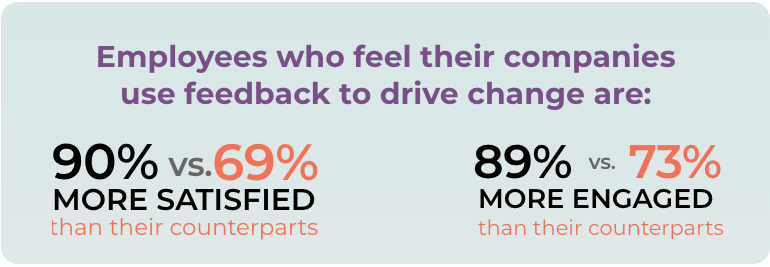The No. 1 Employee Retention Strategy That Actually Works

In the last couple of years, the modern workplace has experienced an undeniable crisis due to recent historical events – employees were forced to transition to remote work as a cause of the COVID-19 pandemic. At the same time, many were laid off or furloughed because of the rising inflation.
Moreover, businesses are dealing with unprecedented levels of turnover, also known as The Great Resignation. What's surprising is that this phenomenon does not only apply to the young workforce but also to more experienced employees.
The Great Resignation indicates that employees are changing their expectations of the workplace and rethinking their priorities – they seek authenticity, transparency, flexibility, and purpose more than ever.
So what can executives and HR managers do to improve employee retention? Nurturing a strong organizational culture is the best strategy to combat employee turnover. After all, employees' wellbeing and job satisfaction are significantly influenced by company culture.
Read on to learn more about the relationship between positive company culture and employee retention and what your organization can do to create a happy workplace for your people.
1. What is employee retention rate?
Employee retention rate is the metric that calculates the percentage of employees who remain with your company during a specific time.
In simpler terms, employee retention refers to the length of time an employee stays with a company.
You can also think of employee retention as the opposite of employee turnover. The latter indicates the percentage of employees leaving your company during a specific period.
Employee retention rate can reveal many clues related to your company's current state, such as the maturity level of your company culture or if your people found the balance between professional and personal life.
Employee retention rate formula
You can find your employee retention rate using a simple formula.
Divide the total number of employees that remained with your company over a specified period by the total number of employees you had on day one. Then multiply that figure by 100:

How to calculate the employee retention rate
Although the formula for calculating employee retention rate is pretty straightforward, as an executive, you should know that there is more to it.
You should first establish the frequency at which you'll calculate your organization's retention rate.
While most companies calculate it yearly, we recommend looking at it every quarter to stay on top of your retention rates. This way, you'll gather more insights that an annual review might miss, such as trends, seasonality, benefits, or performance reviews.
Secondly, determine the number of people employed on the first day of the chosen period and the number of people employed for the whole period. Be mindful of excluding the new hires who began working during that period for this calculation.
Let's take the following scenario. You want to calculate your employee retention rate for the past quarter. You had 50 employees on the first day of the quarter and 42 employees on the last day of the quarter. Your employee retention rate for that period would be (42/50) x 100 = 84%.
2. Why having a strong company culture matters for a high employee retention rate
Employees leave their employment for many reasons, and although many executives might think their people resign due to their salary dissatisfaction, studies show that there is more to this decision. In fact, company culture plays a massive role in this equation.
According to a 2022 survey, 54% of employees said they would leave their company because of poor culture. Additionally, a recent Glassdoor study shows that 77% of job seekers consider a positive corporate culture crucial when evaluating a job offer.

These figures demonstrate that more and more people are reevaluating the reasons for staying with their current employer and how their job fits into their lives. They are looking for organizations with strong cultures that highly value diversity and wellbeing, effective leadership, feedback, flexibility, and growth opportunities.
Healthy workplace culture can play a significant role in the growth and retention of employees. Companies with people-centric cultures that are inclusive and based on trust, transparency, and collaboration will attract and retain top talent and benefit from increased engagement, productivity, and profitability.
Let's take them one at a time.
Engagement
Strong company cultures are closely linked to employees' general wellbeing, ultimately increasing their engagement.
Happy and satisfied employees deliver qualitative work, score better in performance reviews, form stronger relationships with their colleagues, and are more resilient.
When employees' satisfaction and morale are high, they're more involved in their work, invested in their organization, and ultimately more likely to stick around.
Productivity
Engaged employees are more productive as well. According to our article on the current state of employee engagement, companies that engage their people effectively have seen an 18% increase in productivity.
Engaged and productive employees are essential contributors to the business's overall success, resulting in innovation, a better market share, and higher profits.
Profitability
Ultimately, a solid company culture with happy and engaged employees saves time and resources, contributing to increased overall revenue.
According to Glassdoor's research, it costs around $4,000 and 24 days for a U.S. employer to hire a new employee. On top of the expensive costs of hiring, there are a lot of resources across the recruiting, interviewing, onboarding, and training stages that go into this.

Moreover, the company can take up to six months to recover its investment in a new recruit.
In addition to the high costs that low employee retention causes, executives must also consider emotional factors. High turnover rates result in knowledge loss. It also decreases the company's reputation, influencing current or potential employees' decision to stay or come. A low employee retention rate affects cooperation and work relationships. When people come and go, there is no time to consolidate those.
High employee engagement rates, increased productivity, and profitability are deeply rooted in a strong and healthy company culture, which is why an employee decides to stay. As an executive, nurturing a positive workplace culture should be your number one priority, and the rest will follow.
3. Audit your company culture – an executive perspective
Calculating the employee retention rate and understanding how company culture plays a role in retaining your people are probably things you’re already familiar with as an executive.
However, even for people leaders, workplace culture isn’t easy to grasp. So, before getting to the practical tactics that will help you improve your retention rate, you should consider auditing your organizational culture to see where you’re currently at.
A company culture audit is a snapshot that assesses the health of the culture within your organization from your people’s perspective.
An organizational culture audit will help determine if your workplace culture aligns with your business goals. In addition, it will provide insights into the effectiveness of your processes, the state of employee engagement, internal communication, and the overall working environment.
You’ll be able to spot your strengths and weaknesses and establish clear actions to correct them. This analysis can serve as a baseline to refer to over time to shape your company culture and, implicitly, your workplace retention rate.
The key elements of an effective cultural audit are:
👉 assessment: review internal documents, corporate policies, and procedures; gather customer feedback; run a cultural survey to take the pulse of your people;
👉 analysis: collect all the data into a thorough report that can be shared with your employees;
👉 recommendations: develop strategic and tactical next steps to improve your weaknesses.
There are many ways to conduct a company culture assessment, depending on your available resources and how thorough you want to be. The most effective way to audit your organizational culture is to use a combination of research methods:
- Quantitative data (surveys, KPIs, OKRs);
- Qualitative data (interviews, focus groups);
- People analytics data
- Use a performance management tool
Regardless of how you structure your organizational culture audit, talk to your HR team and get them involved. We also recommend taking a stand yourself as an executive by having 1:1 sessions with your key team members and gathering their feedback.
To make the audit process more accessible, we compiled a simple checklist to go through:
✅ company vision, mission, and values;
✅ company policies and procedures;
✅ leadership style;
✅ business goals;
✅ code of conduct and ethics;
✅ internal & external communication;
✅ performance management components;
✅ employee experience;
✅ benefits;
✅ professional growth and development;
✅ team collaboration;
✅ customer experience.
If you want to dig even deeper, take this quick quiz to assess your company culture maturity level and determine areas of improvement.
4. How to strengthen your company culture
Identifying the potential issues that may determine your employees to leave through a culture audit is a necessary action you need to take as an executive.
You also need to be proactive and put all your efforts into creating and nurturing a strong company culture that will create positive employee experiences and ultimately improve your retention rates.
Here are a few quick actions all people leaders should prioritize to strengthen their company culture and drive employee retention.
Encourage feedback
While giving and receiving feedback is not always a comfortable task, research shows that employees expect to receive feedback from their managers and peers. According to a LinkedIn study, 94% of employees would stick longer with a company if it invested in their careers.
Therefore, a strong company culture should encourage constant feedback. Acknowledging your people's achievements will give them the validation they need and prevent them from searching for it elsewhere.

Constructive feedback is also the best motivator to improve and engage more with your company's objectives. Only through a feedback culture can an employee grow and take a step further in their career.
Here are some of the tactics your company can use to encourage a feedback culture:
- Encourage your managers to have regular check-ins with their people where they discuss what went well and what they can improve moving forward;
- Emphasize the importance of giving honest and objective feedback;
- Make a habit of giving public feedback;
Prioritize employee wellbeing
Employees who are engaged but dissatisfied with their jobs are 61% more likely to experience persistent burnout, according to Gallup's State of the Global Workplace 2022 Report.
Burnout is directly tied to toxic working behaviors, which are associated with leaving intent and finally result in attrition.
Prioritizing your employee's wellbeing is fundamental to a positive company culture that values its people.
Before implementing a wellbeing strategy, consider the several components that go into this:
- Financial wellbeing. Although salary is not the most critical criteria in the decision to stay with an employer, people's overall wellbeing at work is still impacted by it. Ensure you compensate your employees fairly.
- Mental wellbeing. With mental health discussions becoming less taboo, ensure a culture workplace free of the stigma associated with mental health issues. Support your employees' mental health by offering them free therapy sessions, helping them set clear boundaries between personal and professional life, and encouraging them to take time off work whenever needed.
- Social wellbeing. As social beings, forming solid and meaningful relationships is integral to our overall wellbeing. You can satisfy these needs of your employees by encouraging team collaboration and organizing social gatherings outside of work. Consider trying Mirro, a performance management software that boosts the social component of a company by creating a space where people can celebrate each other and create social connections.

Create alignment with company values and goals (OKRs)
Solid company values, a clear company vision, and an OKR tool will help your people find purpose and meaning in their role.
Incorporating all these elements into your business plan will automatically attract and retain the right people for your company. Plus, employees who feel they share similar values with their employer will make wiser business decisions, be more loyal, and ultimately make them stay longer.
Put your business' values into practice when evaluating the performance of your people. Make a habit of openly communicating your vision and strategy with your employees and seeing what it means to them. All of these will ultimately improve employee engagement, motivation, and retention.
While having clearly defined company values, vision, and strategy is crucial, more is needed to nurture a strong company culture. As an executive, it's your job to publicize and incorporate them into everything your business does, including your objectives.
The best decision you can take as an executive is to align company values with OKRs because you can then bring your team members together around a common goal and inspire them to work with purpose.
This well-known technique aids each employee in comprehending their specific contribution to accomplishing these objectives.
If you want to learn more about setting effective OKRs and how to use them effectively to drive business success, download our free eBook.
Boost your company culture to drive retention
As an executive, you already know how essential employee retention is for your business’ success.
In addition to giving you insight into your previous employees' experiences, knowing your retention rate can help you attract the best talent.
It is important for prospective employees to know that those currently employed there are happy and satisfied with their jobs, which is typically reflected by your retention rate.
Hopefully, this article gave you all the necessary tools to increase employee retention and improve culture in the workplace. After all, a positive company culture can make an employee stay longer with your organization.
If you want to learn more about the rise of company culture on the leadership agenda, access our free eBook. This comprehensive guide to company culture will offer you all the resources you need to strengthen your organization’s culture.





